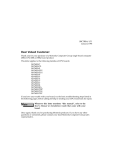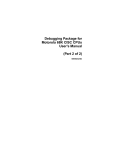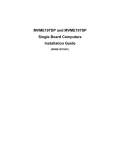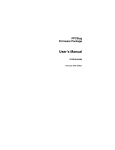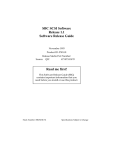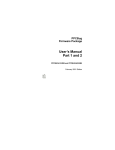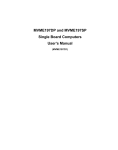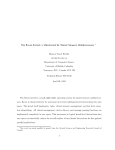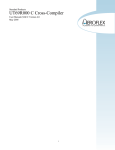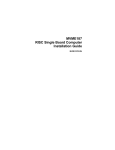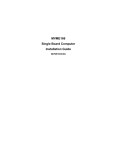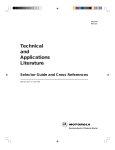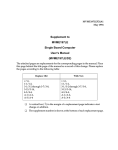Download Local
Transcript
MVME197BUG/D1A1 August 1994 Supplement to MVME197BUG 197Bug™ Debugging Package User’s Manual (MVME197BUG/D1) The attached pages are replacements and/or additions to the user’s manual. They correct minor errors and update some features. Please replace the pages according to the following table and place this page behind the title page of the user’s manual as a record of this change: Replace Old v/vi, xvii/xviii, 1-3/1-4, 1-7/1-8, 1-11 through 1-14, 3-53 through 3-56, 3-63/3-64, 5-3/5-4, 5-73/5-74, A-1 through A-4, IN-5/IN-4, IN-9/IN-10, IN-13/IN-14 With New v/vi, xvii/xviii, 1-3/1-4, 1-7/1-8, 1-11 through 1-14, 3-53 through 3-56, 3-63/3-64, 5-3/5-4, 5-73/5-74, A-1 through A-4, IN-5/IN-4, IN-9/IN-10, IN-13/IN-14 ❏ A vertical bar (|) in the margin of a replacement page indicates a text change or addition. ❏ The supplement number is shown at the bottom of each replacement page. Notice While reasonable efforts have been made to assure the accuracy of this document, Motorola, Inc. assumes no liability resulting from any omissions in this document, or from the use of the information obtained therein. Motorola reserves the right to revise this document and to make changes from time to time in the content hereof without obligation of Motorola to notify any person of such revision or changes. No part of this material may be reproduced or copied in any tangible medium, or stored in a retrieval system, or transmitted in any form, or by any means, radio, electronic, mechanical, photocopying, recording or facsimile, or otherwise, without the prior written permission of Motorola, Inc. Restricted Rights Legend If the documentation contained herein is supplied, directly or indirectly, to the U.S. Government, the following notice shall apply unless otherwise agreed to in writing by Motorola, Inc. Use, duplication, or disclosure by the Government is subject to restrictions as set forth in subparagraph (c)(1)(ii) of the Rights in Technical Data and Computer Software clause at DFARS 252.227-7013. Motorola, Inc. Computer Group 2900 South Diablo Way Tempe, Arizona 85282-9602 The following conventions are used in this document: bold is used for user input that you type just as it appears. Bold is also used for commands, options and arguments to commands, and names of programs, directories, and files. italic is used for names of variables to which you assign values. Italic is also used for comments in screen displays and examples. courier is used for system output (e.g., screen displays, reports), examples, and system prompts. <RETURN> represents the carriage return key. CTRL represents the Control key. Execute control characters by pressing the CTRL key and the letter simultaneously, e.g., CTRL-d. MVME197BUG/D1A1 Related Documentation The following publications are applicable to the MVME197 module series and may provide additional helpful information. If not shipped with this product, they may be purchased by contacting your Motorola sales office. Document Title MVME197LE Single Board Computer User’s Manual Motorola Publication Number MVME197LE MVME197LE Single Board Computer Support Information SIMVME197LE MVME197DP and MVME197SP Single Board Computer User’s Manual MVME197 MVME197DP and MVME197SP Single Board Computer Support Information SIMVME197 MVME197LE, MVME197DP, and MVME197SP Single Board Computers Programmer’s Reference Guide MVME197PG MVME197BUG 197Bug Diagnostic Firmware User’s Manual MVME197DIAG MVME712M Transition Module and P2 Adapter Board User’s Manual MVME712M MVME712-12, MVME712-13, MVME712A, MVME712AM, and MVME712B Transition Module and LCP2 Adapter Board User’s Manual MVME712A MC68040/MC68EC040/MC68CL040 Microprocessor User’s Manual M68040UM/AD MC88110 Second Generation RISC Microprocessor User’s MC88110UM/AD Manual MC88410 Secondary Cache Controller User’s Manual N otes MC88410UM/AD 1. The support information manuals (SIMVME197LE and SIMVME197) contain: the connector interconnect signal information, parts lists, and the schematics for the specific board indicated. MVME197BUG/D1A1 List of Figures FIGURES Figure 1-1. Flow Diagram of 197Bug Start-Up for BOOT ROM.......................... 1-3 Figure 1-2. Flow Diagram of 197Bug Start-Up for FLASH-based Debugger.................................................................................... 1-7 Figure 1-3. Flow Diagram of 197Bug Field Service Menu Operational Mode ................................................................... 1-13 Figure 1-4. Network Boot Support Modules........................................................ 1-33 Figure A-1. Flow Diagram of 197Bug Field Service Menu Operational Mode .................................................................... A-2 MVME197BUG/D1A1 xvii xviii MVME197BUG/D1A1 Start-Up Flow Diagrams 1 2 RESET INITIALIZE MPU REGISTERS SET PSR CLEAR LINKER REGISTERS CLEAR ASIC PROBE FLAG CLEAR FPU STATUS CLEAR CONFIDENCE TEST FLAG ARE WE THE MASTER MPU? YES NO CLEAR MASTER INDICATOR (MPU REGISTER) INITIALIZE BUSSWITCH ADDRESS DECODERS ENABLE ONBOARD I / O DEVICES ENABLE ACCESS TO VMEBUS SPIN UNTIL RELEASED BY MASTER MPU GO TO FLASH IS FLASH EMPTY? NO YES SET MASTER INDICATOR (MPU REGISTER) SET FLAG SET UP BUSSWITCH SEMAPHORE IN BUSSWITCH GPRS TO LOCK SLAVE MPU’S EXTERNAL CACHE OR MULTIPLE MPUS RELEASE SLAVE MPU’S TO REQUEST BUS NO DELAY FOR SLAVE CHECK-IN TO SEMAPHORE YES ENABLE EXTERNAL CONTROL FUNCTIONS IN BUSSWITCH DISABLE BOOT ROM DECODE AT ZERO 2 1 3 Figure 1-1. Flow Diagram of 197Bug Start-Up for BOOT ROM (Sheet 1 of 4) MVME197BUG/D1A1 1-3 1 1 197Bug General Information 3 4 DOUBLE BUTTON RESET? YES FUNCTIONAL DEBUGGER RAM FOUND? NO FLASH EMPTY FLAG SET? YES NO JUMP TO FLASH FAIL LIGHT YES NO CONFIGURE HARDWARE PER ROM DEFAULT PARAMETERS GO TO FLASH (NOTE: NORMAL RESET PATH) WAIT FOR ABORT BUTTON RELEASE CLEAR BUSSWITCH ROM0 BIT TO ENABLE DRAM DECODE MEMORY TEST ON SPECIFIED DEBUGGER WORK PAGE (64 KILOBYTES) AS PER ROM PARAMETERS (MEMORY SEARCH DIRECTIVES) POWER-UP? NO YES INVALIDATE MPU CACHES CLEAR DEBUGGER WORK PAGE SET POWER-UP INDICATOR CLEAR WARM START FLAG CONFIDENCE TEST PENDING INTERRUPT CHECK INITIALIZE DEBUGGER VARIABLES (STACK, VECTOR TABLES, ETC.) SET UP SINGLE MEMORY SUBSYSTEM FIND AND TEST DEBUGGER WORKSPACE RAM INITIALIZE BOARD IDENTIFIER BLOCK INITIALIZE EXCEPTION HANDLING 4 5 Figure 1-1. Flow Diagram of 197Bug Start-Up for BOOT ROM (Sheet 2 of 4) 1-4 MVME197BUG/D1A1 Start-Up Flow Diagrams 1 RESET INITIALIZE AS SLAVE MPU INITIALIZE MPU REGISTERS SET PSR CLEAR LINKER REGISTERS CLEAR ASIC PROBE FLAG CLEAR FPU STATUS CLEAR CONFIDENCE TEST FLAG COMMAND POINTER SEMAPHORE VALID? INITIALIZE BUSSWITCH ADDRESS DECODERS ENABLE ONBOARD I / O DEVICES ENABLE ACCESS TO VMEBUS EXTERNAL CACHE OR MULTIPLE MPUS? 2 NO YES EXECUTE COMMAND NO DOUBLE BUTTON RESET? NO YES YES ENABLE EXTERNAL CONTROL FUNCTIONS IN BUSSWITCH ARE WE THE MASTER MPU? WAIT FOR ABORT BUTTON RELEASE CLEAR BUSSWITCH ROM0 TO ENABLE DRAM DECODE YES NO INVALIDATE MPU CACHES SPIN ON SEMAPHORE UNTIL RELEASED BY MASTER CONFIDENCE TEST PENDING INTERRUPT CHECK 1 2 3 Figure 1-2. Flow Diagram of 197Bug Start-Up for FLASH-based Debugger (Sheet 1 of 6) MVME197BUG/D1A1 1-7 1 1 197Bug General Information 4 3 SET UP ALL RAM SUBSYSTEMS ENABLE ONLY THE LARGEST DRAM SUBSYSTEM AT ZERO MOVE ALL OTHERS TO $80000000 TEMPORARILY MAP AND ENABLE REMAINING MEMORY SUBSYSTEMS CONFIGURE ADDRESS DECODERS MEMORY TEST ON SPECIFIED DEBUGGER WORK PAGE (64 KILOBYTES) AS PER NVRAM / ROM PARAMETERS (MEMORY SEARCH DIRECTIVES) FIND AND TEST DEBUGGER WORK SPACE RAM FUNCTIONAL DEBUGGER RAM FOUND? YES POWER-UP? NO NO YES JUMP TO FLASH FAIL LIGHT CLEAR DEBUGGER WORK PAGE SET POWER-UP INDICATOR CLEAR WARM START FLAG SET SYSFAIL NEGATE FLAG DOUBLE BUTTON RESET? YES NO INITIALIZE DEBUGGER VARIABLES (STACK, VECTOR TABLES, ETC.) SET SYSFAIL NEGATE FLAG CONFIGURE HARDWARE PER NVRAM PARAMETERS INITIALIZE BOARD IDENTIFIER BLOCK INITIALIZE EXCEPTION HANDLING CONFIGURE HARDWARE PER ROM DEFAULT PARAMETERS 4 INITIALIZE CHARACTER I / O PORTS CLEAR CHARACTER I / O BUFFERS 5 Figure 1-2. Flow Diagram of 197Bug Start-Up for FLASH-based Debugger (Sheet 2 of 6) 1-8 MVME197BUG/D1A1 Start-Up Flow Diagrams 9 NO 10 ROM BOOT ENABLED AND ROM BOOT CODE INSTALLED? SYSTEM MODE? NO YES YES HALT WAIT 5 SECONDS FOR ANY CHARACTER TO HALT GO TO TARGET STATE EXECUTE ROM BOOT CODE DISABLE AUTOBOOT CHECKS NO HALT AUTO BOOT ENABLED? EXECUTE SELFTEST NO YES ST FAILURE? NO YES ATTEMPT AUTO BOOT DISABLE AUTOBOOT CHECKS IF AUTO BOOT LOAD OKAY? SYSFAIL NEGATE FLAG TRUE? NO NO YES YES GO TO TARGET STATE EXECUTE AUTO BOOT CODE NEGATE SYSFAIL AUTO BOOT CHECKS DISABLED? NETWORK BOOT ENABLED? NO 10 NO YES YES GO TO MAIN (MONITOR) GO TO MAIN (MONITOR) Figure 1-2. Flow Diagram of 197Bug Start-Up for FLASH-based Debugger (Sheet 5 of 6) MVME197BUG/D1A1 1-11 1 1 197Bug General Information MAIN FIELD SERVICE MENU ENABLED? YES GO TO FIELD SERVICE MENU NO DISPLAY DEBUGGER PROMPT NO INPUT? YES GO TO MAIN TARGET CODE EXECUTION? YES NO EXECUTE COMMAND RESTORE TARGET STATE EXECUTE TARGET CODE EXCEPTION SAVE TARGET STATE DISPLAY TARGET REGISTERS GO TO MAIN Figure 1-2. Flow Diagram of 197Bug Start-Up for FLASH-based Debugger (Sheet 6 of 6) 1-12 MVME197BUG/D1A1 Start-Up Flow Diagrams FIELD SERVICE MENU DISPLAY SERVICE MENU CONTINUE SYSTEM START-UP DISPLAY SYSTEM TEST ERRORS SELECT ALTERNATE BOOT DEVICE DUMP MEMORY TO TAPE GO TO SYSTEM DEBUGGER START CONVERSATION MODE INITIATE A SERVICE CALL EXIT CONCURRENT MODE ERROR EXTENSIVE SYSTEM SELF TEST NO ERRORS ERROR AUTO BOOT FROM SPECIFIED DEVICE NO ERRORS GO TO TARGET STATE EXECUTE “BOOTED” CODE Figure 1-3. Flow Diagram of 197Bug Field Service Menu Operational Mode MVME197BUG/D1A1 1-13 1 1 197Bug General Information Comparison with M68000-Based Firmware Those users who have used one or more of Motorola's other debugging packages will find 197Bug very similar, after making due allowances for the architectural differences between the M68000 and M88000 CPU architectures. These are primarily reflected in the instruction mnemonics and addressing modes of the assembler/disassembler, and in the use of registers instead of the stack for the passing of arguments to or from the TRAP #496 handler. Some effort has also been made to make the interactive commands more consistent. For example, delimiters between commands and arguments may now be commas or spaces interchangeably. 197Bug Implementation FLASH-Based Debugger 197Bug is contained in the FLASH memory devices located on the MVME197 board. The FLASH devices are electrically re-writable and may be reprogrammed without removing the physical devices from the MVME197 board. This allows the user to incorporate updated versions of the 197Bug as they become available by simply loading the newer version into the FLASH memory and overwriting the older version. The PFLASH command (refer to the 197Bug Debugger Command Set chapter) describes how to reprogram the FLASH memory contents. The executable code is checksummed at every power-on or reset firmware entry. Users are cautioned against reprogramming of the FLASH memory contents unless rechecksum precautions are taken. Refer to the CS command description in the 197Bug Debugger Command Set chapter for checksum information. ! WARNING Reprogramming any portion of FLASH memory will erase everything currently contained in FLASH, including the debugger. A valid version of 197Bug must be transferred from RAM into the FLASH during FLASH reprogramming in order for the debugger to operate. The 197Bug Debugger Command Set chapter describes the command set of the FLASH-based debugger. BOOT ROM A subset of 197Bug is also programmed into the BOOT ROM, which is an EPROM or One-Time Programmable ROM on the MVME197 module. This scaled-down 197Bug is referred to as the “BootBug”, or “197BBug”. 1-14 MVME197BUG/D1A1 Set Environment to Bug/Operating System Set Environment to Bug/Operating System ENV ENV [;[D]] The ENV command allows the user to interactively view/configure all Bug operational parameters that are kept in Battery Backup RAM (BBRAM), also known as Non-Volatile RAM (NVRAM). The operational parameters are saved in NVRAM and used whenever power is lost. Any time the Bug uses a parameter from NVRAM, the NVRAM contents are first tested by checksum to ensure the integrity of the NVRAM contents. In the instance of BBRAM checksum failure, certain default values are assumed as stated in the examples below. The bug operational parameters (which are kept in NVRAM) are not initialized automatically on power up/warm reset. It is up to the Bug user to invoke the ENV command. Once the ENV command is invoked and executed without error, Bug default and/or user parameters are loaded into NVRAM along with checksum data. If any of the operational parameters have been modified, these new parameters will not be in effect until a reset/powerup condition. If the ENV command is invoked with no options on the command line, the user is prompted to configure all operational parameters. If the ENV command is invoked with the option D, ROM defaults will be loaded into NVRAM. Programming the VMEbus to Local Peripheral Bus Map Decoders The VMEbus slave map decoders allow a VMEbus master to view a block of the local peripheral bus (usually memory) through a VMEbus window. The following procedure can be used with the ENV command to configure the VMEbus to Local Peripheral Bus (slave) map decoders. This is not the only procedure that can be used to program the map decoders. 1. Determine the local base address (for onboard DRAM memory this is the Base Address of Local Memory) and size of the memory block to be viewed through the VMEbus window. The following restrictions must be considered when defining the local peripheral bus address of the block and the block size. The map decoder logic performs address translation by replacing a portion of the VMEbus address with an address from the address translation register. Therefore, translation is performed in increments of the block size and the block size must be a power of 2 and located on a power of 2 boundary. For example, a 32MB block cannot be addressed on MVME197BUG/D1A1 3-53 3 197Bug Debugger Command Set ENV a 4MB boundary. However, any 4MB block of the 32MB memory can be addressed on any 4MB boundary. 3 Also note that if the block size is not a power of 2, then rounding up to a power of 2 boundary is necessary. For example, a 12MB block must be accessed at 0, 16MB, 32MB, etc. 2. Set the Slave Address Translation Address Register parameter with the LOCAL base address of the block. 3. Set the Slave Address Translation Select Register parameter with the 2's compliment of the block size. 4. Set the Slave Starting Address Register parameter with the starting address of the VMEbus window. 5. Set the Slave Ending Address Register parameter with the ending address of the VMEbus window. N ote The VMEbus window size may be any number of 64KB blocks up to the block size. 6. If the VMEbus window is entirely below the 16MB boundary, enable A24 and/or A32 addressing. If the VMEbus window is entirely above the 16MB boundary, enable only A32 addressing. If the VMEbus window spans the 16MB boundary, enable A32 addressing. If access is required to the portion below the 16MB boundary using A24 addressing, the second map decoder should be programmed to provide A24 access to the portion of the VMEbus window below the 16MB boundary. Set the Slave Control parameter to $01EF to enable A32 addressing, $01DF to enable A24 addressing, and $01FF to enable A32 and A24 addressing. Configuring ENV Parameters The parameters to be configured are: Bug or System environment [B/S] = S? 3-54 B Disables automatic execution of extended confidence testing (ST) on any reset and selects the 197-Bug> prompt in the debugger command line mode. The SD command must be issued to allow diagnostic execution. S Enables automatic execution of extended confidence testing (ST) on any reset. Also, selects the 197-Diag> prompt, enabling diagnostic test execution from the debugger command line. MVME197BUG/D1A1 Set Environment to Bug/Operating System ENV Field Service Menu Enable [Y/N] = Y? Y N Field service menu mode is selected. The menu operation is explained in Appendix A. (Default) Debugger command line mode is selected. The 197-Bug or 197Diag prompt will be displayed based on the Bug or System environment parameter. Remote Start Method Switch [G/M/B/N] = B? The Remote Start Method Switch is used when the MVME197 is crossloaded from another VME-based CPU, to start execution of the crossloaded program. G M B N Use the Global Control and Status Register (GCSR) in the VMEchip2 to pass and start execution of cross-loaded program. Use the Multiprocessor Control Register (MPCR) in shared RAM to pass and start execution of cross-loaded program. Use both the GCSR and the MPCR methods to pass and start execution of cross-loaded program. (Default) Do not use any Remote Start Method. Probe System for Supported Disk/Tape Controllers [Y/N] = Y? Y N Accesses will be made to the VMEbus to determine the presence of supported controllers. (Default) Accesses will not be made to the VMEbus to determine the presence of supported controllers. Negate VMEbus SYSFAIL* Always [Y/N] = N? Y N Negate VMEbus SYSFAIL during board initialization. Negate VMEbus SYSFAIL after successful completion or entrance into the bug command monitor. (Default) Local SCSI Bus Reset on Debugger Setup [Y/N] = Y? Y N Local SCSI bus is reset on debugger setup. Local SCSI bus is not reset on debugger setup. Local SCSI Bus Negotiations Type [A/S/N] = A? A S N MVME197BUG/D1A1 Use Asynchronous negotiations on the Local SCSI bus. Use Synchronous negotiations on the Local SCSI bus. (None). Do not precede the SCSI data transfer with a type negotiation. Do all data transfers in Asynchronous mode. 3-55 3 197Bug Debugger Command Set ENV Ignore CFGA Block on a Hard Disk Boot [Y/N] = Y? Y 3 N Enable the ignorance of the Configuration Area (CFGA) Block (hard disk only). Do not enable the ignorance of the Configuration Area (CFGA) Block. Auto Boot Enable [Y/N] = N? Y N The auto boot function is enabled. The auto boot function is disabled. (Default) Auto Boot at power-up only [Y/N] = Y? Y N Auto Boot is attempted at power up reset only. (Default) Auto Boot is attempted at any reset. Auto Boot Controller LUN = 00? Refer to Appendix E for a listing of disk/tape controller modules currently supported by the Bug. The default for this parameter is $0. Auto Boot Device LUN = 00? Refer to Appendix E for a listing of disk/tape devices currently supported by the Bug. The default for this parameter is $0. Auto Boot Abort Delay = 15? Time in seconds that the Auto Boot sequence will delay before starting the boot. The purpose is to allow the user the option of stopping the boot by use of the Break key. The time value is from 0 through 255 seconds. Auto Boot Default String [NULL for an empty string] = <none> The user may specify a string (filename) which is passed on to the code being booted. The maximum length of this string is 16 characters. The default for this parameter is the null string. ROM Boot Enable [Y/N] = N? Y N The ROMboot function is enabled. The ROMboot function is disabled. (Default) ROM Boot at power-up only [Y/N] = Y? 3-56 Y ROMboot is attempted at power up only. (Default) N ROMboot is attempted at any reset. MVME197BUG/D1A1 Set Environment to Bug/Operating System ENV Master Address Translation Select #4 = 00000000? This register defines which bits of the address are significant. A logical one “1” indicates significant address bits, logical zero “0” is non-significant. (Default is 0). Master Control #4 = 00? This defines the access characteristics for the address space defined with this master address decoder. The default is $00. Short I/O (VMEbus A16) Enable [Y/N] = Y? Y N Yes, Enable the Short I/O Address Decoder. (Default) Do not enable the Master Address Decoder. Short I/O (VMEbus A16) Control = 01? This defines the access characteristics for the address space defined with the Short I/O address decoder. The default is $01. F-Page (VMEbus A24) Enable [Y/N] = Y? Y N Yes, Enable the F-Page Address Decoder. (Default) Do not enable the F-Page Address Decoder. F-Page (VMEbus A24) Control = 02? This defines the access characteristics for the address space defined with the F-Page address decoder. The default is $02. ROM Speed Bank A Code = 03? ROM Speed Bank B Code = 03? These parameters are used to set up the ROM speed, which is dependent on the MPU clock speed. MPUCLK ROM Speed A and B (Default values) 50 40 33 any other 3 2 2 7 PCC2 Vector Base = 05? VMEC2 Vector Base #1 = 06? VMEC2 Vector Base #2 = 07? These parameters are the base interrupt vector for the component specified. (Default: PCCchip2 = $05, VMEchip2 Vector 1 = $06, VMEchip2 Vector 2 = $07). MVME197BUG/D1A1 3-63 3 197Bug Debugger Command Set ENV VMEC2 GCSR Group Base Address = D0? This parameter specifies the group address ($FFFFXX00) in Short I/O for this board. (Default = $D0). 3 VMEC2 GCSR Board Base Address = 00? This parameter specifies the base address ($FFFFCEXX) in Short I/O for this board. (Default = $00). VMEbus Global Time Out Code = 01? This controls the VMEbus timeout when systems controller. (Default $01 = 64 microseconds). Local Peripheral Bus Time Out Code = 01? This controls the local peripheral bus timeout. (Default $00 =64 microseconds). VMEbus Access Time Out Code = 02? This controls the local peripheral bus to VMEbus access timeout. (Default $02 = 32 milliseconds). 3-64 MVME197BUG/D1A1 System Call Routines Table 5-1. 197Bug System Call Routines (Continued) Code Function Description $0024 .WRITELN Output line (pointer/count format) $0025 .WRITDLN Output line with data (pointer/count format) $0026 .PCRLF Output carriage return and line feed $0027 .ERASLN Erase line $0028 .WRITD Output string with data (pointer/count format) $0029 .SNDBRK Send break $0043 .DELAY Timer delay function $0050 .RTC_TM Time initialization for RTC $0051 .RTC_DT Date initialization for RTC $0052 .RTC_DSP Display RTC time and date $0053 .RTC_RD Read the RTC Registers $0060 .REDIR Redirect I/O of a TRAP #496 function $0061 .REDIR_I Redirect input $0062 .REDIR_O Redirect output $0063 .RETURN Return to 197Bug $0064 .BINDEC Convert binary to Binary Coded Decimal (BCD) $0067 .CHANGEV Parse value $0068 .STRCMP Compare two strings (pointer/count format) $0069 .MULU32 Multiply two 32-bit unsigned integers $006A .DIVU32 Divide two 32-bit unsigned integers $006B .CHK_SUM Generate checksum $0070 .BRD_ID Return pointer to board ID packet $0071 .ENVIRON Access boot environment parameters $0073 .PFLASH Program FLASH Memory $0090 .SIOPEPS Retrieve SCSI pointers (NOTE 3) $0100 .FORKMPU Fork MPU (Multiple MPU Configuration) (NOTE 2) $0101 .FORKMPUR Fork Idle MPU with Register Set (NOTE 2) MVME197BUG/D1A1 5 5-3 System Calls Table 5-1. 197Bug System Call Routines (Continued) Code 5 Function Description $0110 .IDLEMPU Idle MPU (Multiple MPU Configuration) (NOTE 2) $0120 .IOINQ Port Inquiry $0124 .IOINFORM Port Inform $0128 .IOCONFIG Port Configure $012C .IODELETE Port Delete $0130 .SYMBOLTA Attach Symbol Table $0131 .SYMBOLTD Detach Symbol Table $0140 .ACFSTAT ACFAIL Status Inquiry N otes 1. In most examples of commands and displays given in this manual, 197Bug is used. However, the commands, displays, and system calls apply to all 88K RISC debugging packages, unless otherwise noted. 2. This utility is only available on multi-processor modules such as the MVME197 series and the MVME188 series. 3. This function applies only to modules with SCSI; does not apply to MVME188 or MVME188A series modules. 5-4 MVME197BUG/D1A1 .PCRLF Function .PCRLF TRAP FUNCTION: .PCRLF - Print <CR><LF> sequence CODE: $0026 DESCRIPTION: .PCRLF sends a <CR><LF> sequence to the default output port. ENTRY CONDITIONS: 5 No arguments required. EXIT CONDITIONS DIFFERENT FROM ENTRY: None MVME197BUG/D1A1 5-73 System Calls .PFLASH Function .PFLASH TRAP FUNCTION: .PFLASH - Program FLASH memory CODE: $0073 DESCRIPTION: The purpose of this TRAP is to program FLASH memory under program control. The address of the packet is passed as an argument to the function. The address of the packet is passed in the longword memory location pointed to by the current stack pointer. The packet contains the necessary arguments/data to program the FLASH memory. 5 ENTRY CONDITIONS: SP ==> Address: Starting address of control packet longword EXIT CONDITIONS DIFFERENT FROM ENTRY: None FORMAT OF FLASH MEMORY CONTROL PACKET: The FLASH Memory Control Packet must be longword/word (32-bit) aligned. 31 $00 24 23 16 15 5 Status Word 8 7 0 Control Word $04 Source Starting Address $08 Number of Bytes to Program $0C Destination Starting Address $10 Instruction Execution Address Field descriptions: Control/Status Word Specifies control and status of the various phases of the FLASH memory programming. This parameter has two 16-bit parts: bits #31 to #16 specify status and bits #15 to #0 specify control. 5-74 MVME197BUG/D1A1 MVME197BUG SYSTEM MODE OPERATION A General Description To provide compatibility with the Motorola Delta Series systems, the MVME197Bug has a special mode of operation for system environments. If system mode is selected in the ENV parameters (default), extended confidence tests are run automatically at power-up or at any reset of the MVME197. A delay precedes this testing and the tests can be skipped by typing “S” on the console keyboard. During this delay, control will be passed to the debugger prompt or menu (see below) if errors are detected. If the field service menu is enabled, a menu will be displayed instead of the debugger prompt, if none of the alternate actions (AB, RB, NBO, etc.) has been enabled via the ENV parameters. This allows several system start-up features to be selected, such as: 1. Continue System Start-Up 2. Select Alternate Boot Device 3. Go to System Debugger 4. Initiate Service Call 5. Display System Test Errors 6. Dump Memory to Tape The flow of menu mode operation is shown in Figure A-1. Upon either power up or system reset, the MVME197 first executes a limited confidence test suite. This is the same test suite that the Bug normally executes on power up when not in the system mode. Upon successful completion of the limited confidence tests, a five second period is allowed to interrupt the start-up sequence. By typing any character the user can cause the module to deviate from the normal start-up sequence and display one of the debugger prompts or display the field service menu, permitting the selection of an alternate boot device, entry to the debugger, etc., as described above. Upon selection of “continue startup” the module conducts a more extensive confidence test (ST). Successful completion of the extended confidence test initiates the autoboot sequence, with boot taking place either from the default device (refer to the 197Bug Debugger Command Set chapter for information on entering/changing the default boot device) or from the selected boot device if an alternate device has been selected. MVME197BUG/D1A1 A-1 A MVME197Bug System Mode Operation If the limited confidence test fails to complete correctly, the FAIL LED may blink to indicate a failure and processing is suspended. FIELD SERVICE MENU DISPLAY SERVICE MENU CONTINUE SYSTEM START-UP DISPLAY SYSTEM TEST ERRORS SELECT ALTERNATE BOOT DEVICE DUMP MEMORY TO TAPE GO TO SYSTEM DEBUGGER START CONVERSATION MODE INITIATE A SERVICE CALL EXIT CONCURRENT MODE ERROR EXTENSIVE SYSTEM SELF TEST NO ERRORS ERROR AUTO BOOT FROM SPECIFIED DEVICE NO ERRORS GO TO TARGET STATE EXECUTE “BOOTED” CODE Figure A-1. Flow Diagram of 197Bug Field Service Menu Operational Mode A-2 MVME197BUG/D1A1 Menu Details Error message explanations for the extended confidence test are given in the heading for the failed test. Menu Details Following are more detailed descriptions of the menu selections. Continue System Start Up The only action required by the user is to enter a 1 followed by a carriage return. The system then continues the start-up process by performing extended confidence testing (ST) followed by a system boot from the device specified by the ENV parameters active. Select Alternate Boot Device After entering a 2, the user is prompted with: Enter Alternate Boot Device: Controller: Drive : File :. The selection of devices supported by the 197Bug is listed in Appendix E. Entry of a selected device followed by a carriage return redisplays the menu for another selection, normally “continue system start-up” at this point. Go to System Debugger When 3 is selected, this entry places the user in 197Bug diagnostic mode, if system mode is selected, indicated by the prompt 197-Diag>. If desired, return to the menu can be accomplished by typing “menu” when the Bug prompt appears. If not in system mode, the 197-Bug> prompt will be displayed and the user must type “SD” to enable diagnostic execution. When in 197-Diag mode, operation is defined by the MVME197BUG 197Bug Diagnostic Firmware User’s Guide. Initiate Service Call The initiate service call function (enter 4) is described in the following sections. General Flow Initiated by typing a 4 <CR> in response to the menu prompt, this function is normally used to complete a connection to a service organization which can then use the “dual console” mode of operation to assist a customer with a problem. Interaction with the service call function proceeds as follows: MVME197BUG/D1A1 A-3 A A MVME197Bug System Mode Operation First, the system asks: Modem Type: 0) Terminal 1) Manual 2) UDS-2122662 3) UDS-2122980 (Hayes) 4) UDS-2123382 (Hayes) Your Selection ( )?. Explanation: UDS means that the modem is compatible with the UDS modem protocol as used in internal Delta Series modems. The model number of this modem is UDS 2122662. Hayes means that the modem is compatible with a minimal subset of the Hayes modem protocol. This minimum subset is chosen to address the broadest spectrum of Hayes compatible modem products. Note that the modem itself is not tested when Hayes protocol is chosen, while the modem is tested with the UDS protocol choice. Manual mode connects directly to the modem in an ASCII terminal mode, allowing any nonstandard protocol modem to be used. Terminal mode is used to connect any ASCII terminal in place of a modem, via a null modem, or equivalent cable. It is useful in certain troubleshooting applications for providing a slave terminal without the necessity of dialing through a modem. When a selection of one of the above options is made (option 0 in this case), the system asks: Do you want to change the baud rate from 1200 (Y/N)? Note that any question requiring a Y or N answer defaults to the response listed furthest to the right in the line (i.e., a question with Y/N defaults to NO if only a carriage return is entered. If the user answers Y to the baud rate question, the system prompts: Baud rate [300, 1200, 2400, 4800, 9600] 1200? A-4 MVME197BUG/D1A1 Define Constant Directive 4-2 define macros 3-106 delay, timer 5-14 delete breakpoint 3-22 delete I/O port 5-46 delete macros 3-106 delimiter 2-2 Delta Series A-1 description of 197Bug 1-1 detach port 3-154 detach printer 3-149 detach symbol table 3-182, 5-91 detach/format port 3-150 Device Descriptor Packet 5-16 Device Descriptor Table 1-29, 3-84, 3-91 Device LUN (DLUN) 3-13, 3-19, 3-86, 3-92, 3-112, 3-127, 3-128, 3-144, 5-17 device LUN (DLUN) 3-82 device name 3-161 device parameters, default 1-32 device probe 3-84 device probe function 1-29 DI option 3-114, 3-117, 4-7 diagnostic directory 1-37, 3-176 diagnostic facilities 1-37 diagnostic mode A-3 diagnostic prompt 1-2, B-2 diagnostic, memory map 3-121 diagnostics 3-170 direct access device E-2, E-3 Directives 4-1 directory 3-176 directory, switch 3-176 disable ROMboot 3-159 Disassembled Source Line 4-3 disassembler 4-3 disassembler, one-line 3-48 disk access, physical 3-86 disk configuration 3-91 disk control 5-20 disk controller default configuration E-2 MVME197BUG/D1A1 disk I/O control 3-82 disk I/O error codes 1-32 disk I/O support 1-29 disk I/O via 197Bug commands 1-30 Disk I/O via 197Bug System Calls 1-31 disk IOT command parameters E-5 Disk type D-3 disk, configure 5-16 disk, format 5-22 disk, read/write 5-24 Disk/Tape Controller Default Configurations E-2 Disk/Tape Controller Modules Supported E-1 display macros 3-106 display memory 3-114 display offset registers 3-146 display registers 3-161 display symbol table 3-185 Display System Test Errors A-10 display time 5-82 Display Time and Date 3-190 divide integers 5-15 DLUN E-2, E-3, E-4, G-1 DMA Block of Memory Move 3-43 DMA command 3-43 Double Precision 3-114, 3-117, 3-172, 3-173 double precision real 2-8 Double-Button Reset 1-25 drive characteristics D-5 Drive data density D-3 Drive track density D-3 DS command 3-48, 4-7 DU command 3-49 Dump Memory to Tape A-10 Dump S-Records 3-49 dump utilities C-3 E ECC 5-18 ECC data burst length D-2 IN-5 I N D E X Index I N D E X ECHO command 3-51 Echo String 3-51 edit macros 3-109 EIA-232-D port connectors 1-18, 2-6 Embedded servo drive D-3 enable ROMboot 3-159 Enable/Disable Macro Expansion Listing 3-111 encoding C-2 end of tape (EOT) 3-88 Enhanced small device interface (ESDI) 5-10 Entering a Source Line 4-8 entering and debugging programs 2-5 Entering and Modifying Source Programs 4-7 Entering Branch Operands 4-8 entering debugger command lines 2-1 ENV command 3-53 Environment (ENV) command 1-20, 1-22 environment parameters, read/write 5-27 environment, configuring 3-54 environment, preserving 2-6 environment, set 3-53 EOT 5-23 EPROMs 3-159 erase line 5-30 error codes, disk I/O 1-32 error codes, network I/O 1-35 error correction code (ECC) 3-95 Error Handling Codes F-12 errors, system test A-10 escape character 3-191 ESDI Winchester hard drive E-2 Ethernet G-1 Ethernet driver 1-34 Ethernet interface 1-32 exception handler 5-12 exception handler semaphore 3-175 exception vectors used by 197Bug 2-6 EXEC command 1-17 executable instruction 4-2 IN-6 execute debugger 3-174 execute one line 3-185 execute user program 3-71 expansion of macros 3-111 exponent field 2-7 expression 2-2 expression as a parameter 2-2 Extended attributes mask D-2 Extended attributes word D-2 Extended confidence tests A-1 Extended parameters mask D-2 F F option, IOT 3-91 field service menu A-1 file blocks, retrieve 5-66 file number 5-25, A-11 File Zero Structure A-10 file, open for read 5-64 filemark 3-88, 5-25 fill block of memory 3-10 fixed-length buffer 5-77 flag byte 3-87, 5-25 FLASH-Based Debugger 1-14 flexible diskette E-2, E-3 floating point data 3-172, 3-173 floating point instructions 2-7 floating point SFU 2-8 floating point support 2-7 floppy disk command parameters E-5 Floppy disk format D-3 Floppy disk size D-3 floppy drive E-2, E-3 FORK command 3-65 fork idle MPU 5-32 Fork Idle MPU at Address 3-65 Fork Idle MPU with Registers 3-66 fork MPU 5-31 FORKWR command 3-66 format 4-2 format disk 5-22 format/detach port 3-150 MVME197BUG/D1A1 local floppy drive E-3 local peripheral bus map decoders 3-53 logical block 1-29 Logical Unit Number (LUN) 1-30, 3-13, 3-86 longword F-10 loop, read 3-171 loop, write 3-23, 3-199 LUN 3-91 M M 3-117 M= B-3 M68000 F-10 M88000 F-10 M88000 firmware 1-1 MA command 3-106 Machine-Instruction Operation Codes 4-1 Macro Define/Display/Delete 3-106 macro definitions 3-106, 3-109 macro definitions prompt B-3 Macro Edit 3-109 macros, edit 3-109 macros, expansion 3-111 macros, save/load 3-112 MACSI/Controller Error Codes F-11 MAE command 3-109 Main Processor Registers 4-4 MAL command 3-111 mantissa field 2-7 Manual mode A-4 Manual Mode Connection A-8 MAR command 3-112 mask, interrupt request 3-101 MAW command 3-112 MC88110 Assembly Language 4-1 MC88110 CMP instruction 5-88 MC88110 conditional TRAP instructions 5-1 MC88110 exception vectors 2-6 MC88110 instruction set 4-3 MVME197BUG/D1A1 MC88110 machine language 4-1 MC88110 Second Generation RISC Microprocessor User's Manual 2-8 MC88110 TRAP instructions 2-6 MD command 3-114 media characteristics D-5 Memory Address 3-87 memory compare, block 3-8 Memory Display 3-114 memory fill, block 3-10 memory initialize, block 3-15 memory location D-1 Memory Map Diagnostic 3-121 Memory Modify 3-117 memory move, block 3-16 memory move, DMA block 3-43 memory requirements 1-27 memory search, block 3-28 Memory Set 3-123 memory verify, block 3-31 Memory Write 3-124 memory, dump to tape A-10 menu A-1 MENU command 3-116 Menu Details A-3 menu mode operation A-1 menu, help 3-76 Message Command A-6 meta symbols 2-2 MK48T08 5-83, 5-85 MM command 3-117 MMD command 3-121 mnemonics 4-1 Mnemonics and Delimiters 4-3 mode sense 1-29 mode, concurrent 3-33 mode, no concurrent 3-35 modem connection, manual A-8 modem functions 3-168 Modem ID 5-49 modify memory 3-117 modify offset registers 3-146 IN-9 I N D E X Index I N D E X modify registers 3-172 Modulus 4-5 Mono 5-51 move block of memory 3-16 move DMA block of memory 3-43 MPU 5-32 MPU Clock Speed Calculation 1-27 MPU Execution/Status 3-174 MPU registers 3-162 MPU with registers, idle, fork at address 3-66 MPU, fork Idle 5-32 MPU, fork multiple 5-31 MPU, idle multiple 5-41 MPU, idle, fork at address 3-65 MS command 3-123 multiply integers 5-53 Multiprocessor Address Register (MPAR) 1-36 Multiprocessor Control Register (MPCR) method 1-35 multiprocessor support 1-35 MVME197 SCSI Firmware Status Codes F-2 MVME197BUG 1-1 MVME320 E-2 MVME320 Controller-Dependent Status Codes F-4 MVME323 E-2 MVME323 Controller-Dependent Status Codes F-5 MVME327A E-3 MVME327A Controller-Dependent Status Codes F-7 MVME328 E-3 MVME328 Controller-Dependent Status Codes F-11 MVME350 E-4 MVME350 Controller-Dependent Status Codes F-13 MVME374 (AMD AM7990 - LANCE) H-2, H-3 IN-10 MVME376 G-1 MW command 3-124 N N option 3-28, 3-117 NAB command 3-126 NBH command 3-127 NBO command 3-128 negation, SYSFAIL* 1-26 network boot control module 1-35 Network Boot Operating System 3-128 Network Boot Operating System and Halt 3-127 network boot support modules 1-33 network boot, automatic 3-126 network control functions 5-61 network controllers supported G-1 network file open 5-64 network file retrieve 5-66 network header file I-1 Network I/O Control 3-132 network I/O error codes 1-35 Network I/O Physical 3-137 network I/O support 1-32 Network I/O Teach (Configuration) 3-139 network parameters, configure 5-54 Network Ping 3-144 network read/write 5-68 next instruction, go to 3-69 NIOC command 3-132 NIOP command 3-137 NIOT command 3-139 no autoboot 3-6 No Concurrent Mode 3-35 NOAB command 3-6 NOBR command 3-22 NOCM command 3-35 NOMA command 3-106 NOMAL command 3-111 Non- Volatile RAM (NVRAM) 3-53 NOPA command 3-149 MVME197BUG/D1A1 ROMboot function 3-159 RS command 3-173 RTC, storage 3-158 RUN command 3-174 S S option 3-114, 3-117, 3-172, 3-173, 3-183 sample ROMboot routine 1-22 sanity check 3-180 Save/Load Macros 3-112 Scatter/Gather Errors F-12 scientific notation 2-8 SCSI Bus Status F-2 SCSI Command F-1 SCSI Common Command Set (CCS) E-2, E-3 SCSI Errors F-12 SCSI pointers, retrieve 5-86 SCSI status codes F-2 SD command 3-176 search block of memory 3-28 search symbol table 3-185 sector 1-29 sector size D-1 sectors versus blocks 1-29 Sectors/track D-1 Select Alternate Boot Device A-3 self-test 3-170 send break 5-87 send to host 5-68 Sense Key F-1 separating characters 4-4 Sequential access device E-2, E-3 SERIAL PORT 1 2-5 SERIAL PORT 2 2-5 serial port status, input 5-44 Server IP Address 3-127, 3-128 service call, initiate A-3 Set Environment to Bug/Operating System 3-53 set memory 3-123 set registers 3-173 MVME197BUG/D1A1 Set Time and DateSET command 3-177 SETUP command 1-17 Setup System Parameters SETUP 1-17 sign field 2-7 signed hexadecimal 4-3 Single Board Computers E-2 Single Precision 3-114, 3-117, 3-172, 3-173 single precision real 2-8 single quotes 4-6 SIOP Status F-3 slave map decoders 3-53 Small Computer System Interface (SCSI) 5-9 source code 4-7 source line 2-5, 4-1 Source Line Format 4-3 source program 4-1 Source Program Coding 4-2 Spare sectors count D-2 Special Function Unit (SFU) 2-7 Spiral offset D-1 square brackets 2-2 S-record content C-1 S-record example C-3 S-record types C-2 S-record, creating C-3 S-records 3-102 S-records, display 3-49 S-records, verify 3-194 Starting head number D-1 start-up 1-18 startup, continue A-3 static variable space 1-27 static variables 3-169 status codes, controller-dependent F-4, F-5, F-7, F-11, F-13, H-2 status codes, SCSI F-2 status inquiry 5-5 status of MPU 3-174 status packet 5-5 status word F-1, H-1 IN-13 I N D E X Index I N D E X Stepping rate code D-2 stop bits 5-51 String 3-127, 3-128 String Formats for I/O 5-1 String literals 4-5 string literals 2-3 string pool 3-106 string, echo 3-51 string, output 5-72, 5-92, 5-94 string, read 5-78 strings, compare 5-88 supervisor address space 2-4 Switch Directories 3-176 Switch Directories (SD) command 1-2 SYM command 3-179 symbol base address 5-89 symbol table 3-179, 3-182, 3-183 Symbol Table Attach 3-179 Symbol Table Detach 3-182 Symbol Table Display/Search 3-185 symbol table, attach 5-89 symbol table, detach 5-91 SYMS command 3-185 synchronous data link control (SDLC) 5-51 syntactic variables 2-2 syntax 4-2 SYSCALL 4-1 SYSCALL System Call Directive 4-6 SYSFAIL* assertion/negation 1-26 System Call Directive 4-2 System Call Routines 5-2 system calls 5-1 system calls, disk I/O 1-31 System Console 1-18, 5-49 system console terminal 3-33 system controller 3-169 System Fail (SYSFAIL*) 1-20 System ID Number A-5 System Menu 3-116, 3-170 System Mode 1-19, 3-116, 3-168, A-12 system test errors, display A-10 IN-14 T T command 3-185 T option 3-103 T option, IOT 3-92 TA command 3-188 tape controller default configuration E-2 tape dump A-10 Tape Dump File Map Entries A-10 Tape Dump Utility A-10 target IP 3-161, 3-185, 3-192 target register 3-173 temporary breakpoint 3-69, 3-74, 3-192 Terminal Attach 3-188 terminal input/output control 1-27 terminal mode A-4 Terminal Mode Operation A-10 terminal screen 3-194 termination record C-2 TFTP Protocol Module 1-34 TIME command 3-190 time, display 3-190, 5-82 time, initialize 5-85 time, set 3-177 time-of-day clock 3-177, 3-190 timer delay 5-14 TM command 3-191 Trace 3-185 trace functions 3-185, 3-192 Trace to Temporary Breakpoint 3-192 Track density D-3 Track zero data density D-3 transaction address 3-121 Transparent Mode 3-191, A-8 TRAP 4-6 TRAP #496 2-6, 3-91, 5-1, F-1, H-1 TRAP #496 handler 1-1, 5-1 TRAP #496 system calls 1-31 trap exception commands 1-1 TT command 3-192 two-pass assembler 4-2 MVME197BUG/D1A1


































